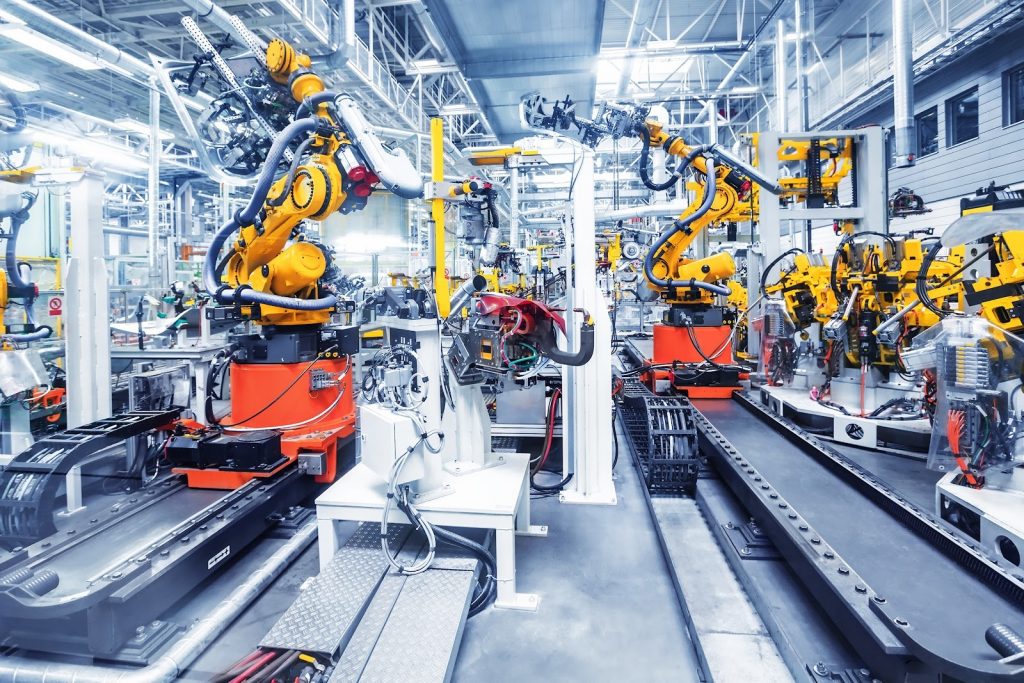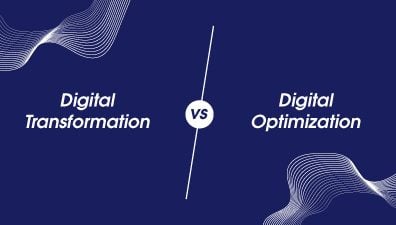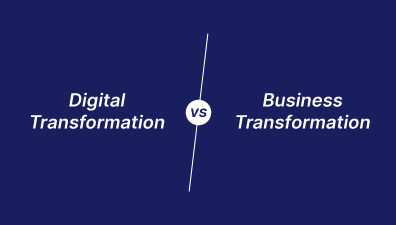Digital transformation opens unprecedented opportunities for all businesses and industries, including manufacturing. By applying digital transformation in manufacturing, businesses are subject to change to expand production, increase productivity and improve existing limitations, but are manufacturers willing to give up the current production method, accept the change, and also risk?
If you are confused standing between these two options, let us encourage you to believe more in that change. This article will provide all the information you need. Digital transformation in manufacturing is not easy to achieve, but once you have full knowledge about it, you will find the fastest way to take advantage of it to lead the market.
Let’s dive in!
Table of Contents
What is digital transformation in manufacturing?
For sure, in the last few years, you hear a lot about the term “digital transformation” next to the rise of the “smart factory” or “industrial 4.0.” So what is digital transformation in manufacturing?
It is simply the impact of science and technology advances, especially the achievement of industrial revolution 4.0, on the field of manufacturing in many businesses. It optimizes the use of data in operation, helping speed up activities and reduce costs, and change the work of the organization to bring breakthrough value to customers. For example, operators can use their sales data to analyze and predict the needs of customers. From there, they will be able to create plans and adjust their production activities to suit them.
However, in all the benefits of digital transformation in manufacturing, productivity improvement is just the beginning. To better understand why we recommend applying it, go deep into profits that make businesses accept risks to change in the next section.
Benefits of digital transformation in manufacturing
In 1975, Kodak’s engineers invented the digital camera, but Kodak put it away because it feared this invention would make people not buy its filmstrips and photo-developing chemicals. Kodak at that time had a place in the market, leading many years in film camera products. You could find their products at any photo shooting in the world. However, the bigger and more successful they get, the slower businesses innovate. While Kodak continues to ignore many other digital conversion opportunities, Many companies have started to realize the long-term benefits of digital transformation. Consequently, the appearance of the iPhone in 2007 and Instagram in 2010 was the direct cause of Kodak’s bankruptcy in 2012. This case of Kodak is a typical example of how important it is to increase the efficiency of the remaining processes and operations.
Here are all the reasons to transform your industrial shop with digital manufacturing technology:
Improved processes
Machinery equipment is one of the direct participation factors of the production process. However, only using machines to increase production is not enough. The machinery equipment modernization and technological innovation have become more critical for every business, helping streamline processes and simplify performance monitoring. Not only that, when people bring digital technology to operating machinery, they can also optimize machinery lifecycles to avoid active interruptions.
Better data usage
Data is playing a significant role in the operation of businesses, which is their valuable property, primarily when smart manufacturing and smart factories are increasingly focused. Digital transformation results from applying good data, but it is also the opportunity for firms to learn how to filter and optimize data more efficiently in specific areas, such as finance, warehouse system, customer care, etc.
Cost-saving
While investment in machinery can save you the cost of labor, storage, and operation, digital transformation can give you a clearer view of internal issues, which create wastefulness, unnecessary risks, and expenses like excessive inventory, delivery, demand cycles, etc. These issues are actually slowing business activities down, but people accidentally do not notice.
Increased innovation
Digital transformation in manufacturing will create innovation in the entire way your business operates, from infrastructure, software to how people connect with each other.
In particular, when business size is growing and reaching out to the world, the need for connection and information sharing in remote meetings will become essential. Therefore, even sooner or later, digital transformation gradually shapes how businesses connect their network in the future.
Smarter outsourcing
Now, people can manage their employees in a smart and comprehensive way without having to watch them anytime, anywhere. Not only that, but digital transformation in manufacturing also helps them to take the initiative in troubleshooting and preventing all disruptions immediately in operation, thereby eliminating risks compared to traditional ways of operation enterprises previously use.
Furthermore, it also ensures safety for manufacturing staff when warning potential hazards and replacing them in a dangerous working environment with robots.
Customer-centricity
An industrial manufacturing enterprise that wants to survive and develop needs to take customers as a focus through building a technological innovation plan. Scientific and technological advances, technology innovation will allow to enhance product quality, diversify products, so it will increase competitiveness. In addition, it also provides opportunities for businesses to come close to consumers through predicting their needs, helping create a superior customer experience.
>> Read more: Digital Transformation in Automotive industry: Trends and Challenges
Challenges of digital transformation in manufacturing
Besides opportunities for businesses, digital transformation also makes many companies afraid to change in some respects. However, you must understand that the business potentials and opportunities from the new digital technology will have unique requirements for the skills as well as the flexibility of both managers and employees. Hence, no matter what the challenges of digital transformation in manufacturing here are, you can finally find the light to deal with them. The way to perform digital transformation is starting from small steps, with a clear strategic plan.
So what are the biggest obstacles when a digital conversion happens in organizations and businesses?
- Competition priority – personnel does not apply technology now.
- Not fluent in digital – personnel does not know how to use.
- Vague about the results after applying digital transformation in manufacturing.
- Threaten the current power structure – personnel fear of losing power.
- Fear risks, do not want to venture.
Each business will have different ways of operation and business culture. Consequently, the challenges for them are not the same. Here, we summarize the four main difficulties that businesses often face.
Low-quality human resources
In order to master new technology, companies need staff that can ensure the quality of technology and technology inventions to surpass large competitors in the market. However, in developing countries, the number of laborers like this accounts for a tiny part of the enterprise.
Lack of budgets and resources
This is one of the main reasons why companies, especially small and medium enterprises, hesitate to make a digital conversion as they have many activities to invest effort and time in. Therefore, when deciding to make digital transformation in manufacturing, leaders will have to calculate resources and costs to balance all areas carefully.
Lack of motivation to promote the change of organization
The investment in technology can be pretty expensive initially, but gradually, you will see the digital transformation in manufacturing absolutely worthy of investing. Unfortunately, many companies only see immediate revenue without sticking with long-term digital conversion strategies, causing them not to bring any results.
Additionally, the lack of motivation to change is also from a limited number of personnel who are narrow in perspective and thinking, not wanting to change and try new things. At this time, businesses need to help their employees have the appropriate approach, cultivating enough knowledge and skills through courses and training sessions in the business.
Instability in an economic and political situation
Digital transformation not only takes place within the company, but it also has to adapt to a change in the economic and political situation. These factors are the primary agent to make a change in consumer needs. The best way is that enterprises have a specific plan of digital transformation in manufacturing along with the ability to determine a close and detailed timeline. Thus, they can respond promptly to changes in the economic and political situation.
Digital transformation in manufacturing: in-house vs. outsource
To use digital transformation in manufacturing, you have the option of having an in-house team or outsourcing. Each has its own pros and cons. Therefore, you need to consider your company’s context to choose the most appropriate approach.
In-house team
Pros
- You’ll have complete control over the production operations run by your employees.
- Trained employees will have a deeper insight into the business values of the business compared to outsourcing.
- Employees will be trained in more depth in specific areas to meet the essential needs of a particular company.
Cons
- Finding a quality team is not easy, not to mention the personnel and training costs are not small.
- Finding and training employees will take longer than outsourcing, not suitable for companies that need to transform in a short time.
Outsourcing
Pros
- Cost and time efficiency are obvious. These service providers have teams that can work for you anywhere, anytime.
- These people’s expertise in digital transformation in manufacturing will be higher, ensuring quality.
- Scalability is flexible, depending on your needs at each time.
Cons
- The complexity of communication can cause the outsourcing provider to misunderstand the problem and cannot solve it.
- You won’t have 100% quality control.
Successful digital transformation in manufacturing case study
Cisco
Cisco is a company that specializes in high-tech products in the US. Its products are outsourced so that they can meet demand around the world at a low cost.
However, the challenge posed by outsourcing is that it is difficult for this company to control production processes as well as product quality. Therefore, this digital transformation in the manufacturing case study is about developing software that enables the company to monitor supply chain quality in real-time. As a result, Cisco’s production has not ever been delayed while ensuring product quality.
Polaris
Polaris is no stranger to those who are passionate about skiing and terrain sports. It is a company that supplies sports vehicle products on all terrains. Therefore, safety and premium design are the criteria that this company always aims at for its customers.
To engage its audience, Polaris personalized the customer experience by applying digital transformation in product design, manufacturing, and maintenance.
Lavifood
If you regularly visit supermarkets, you will notice this Vietnamese brand’s clean vegetable products. By using a suite of technologies to achieve digital transformation, Lavifood has reached agreements to deliver agricultural products to consumers around the world. Digital transformation in manufacturing not only helps the company digitize its manufacturing processes but also lowers downtime, keeping the quality of its fruits and vegetables high in all circumstances.
Samuel Hubbard
Samuel Hubbard has a long-standing international reputation in the fashion industry. The more this business grows, the greater the need to reduce time spent on coordinating and manual data entry is to focus on other core business activities. As a result, it incorporates the use of B2C data from the Magento eCommerce platform and B2B data from OroCommerce. This has helped it improve the customer experience, thereby increasing sales from both types of customers.
Our last words
The breakthroughs of digital technology are pregnant for decades and just popularly applied for several years, especially in the manufacturing industry. Therefore, if you know how to take advantage of digital transformation in manufacturing from now, it will open a lot of opportunities for you not to be lagging but lead the market. From Kodak’s path of failure, do you choose to go digital or die? It’s up to you.
If you want to know deeper information about digital transformation in the manufacturing industry, feel free to contact us. We will provide more tips and tricks so you can apply them to your case.

















